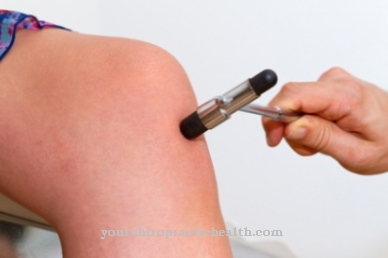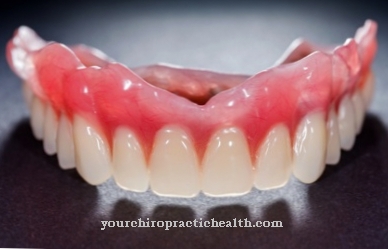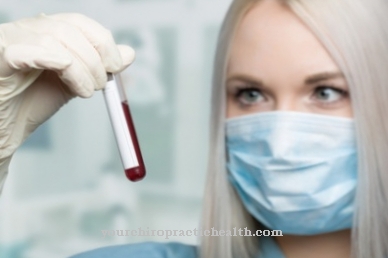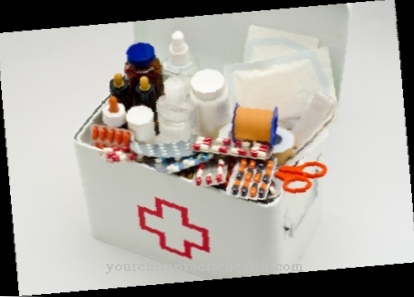Hydrogel is a polymer that has a high content of water and at the same time is not water-soluble. As a polymer, the substance consists of macromolecules in a three-dimensional network, which swell in contact with a solvent and yet retain their cohesion. Hydrogel plays a role in medical technology for wound dressings, lenses and implants.
What is hydrogel

Hydrogel is a water-containing and at the same time water-insoluble polymer. Hydrogel molecules are chemically linked to form three-dimensional networks, for example by ionic or covalent bonds. They can also be physically linked to form a network, for example by entangling polymer chains. In water they swell up due to a built-in and hydrophilic polymer component and thus get a high increase in volume. The material cohesion remains unchanged.
Hydrogels play a role in a considerable number of biotechnological developments, for example in the form of contact lenses. Due to their biocompatibility and tissue-like mechanical properties, they are also ideal for administering active ingredients and treating wounds.
In medicine, the term hydrogels also stands for a wound dressing made of gels with a high water content. The aqueous gels liquefy under the action of mechanical forces. In the meaning of wound dressings, hydrogels are also referred to as hydrophilic gels. In this context, a distinction is made between hydrogel and hydrocolloid dressing, which has a matrix of swelling agents.
Shapes, types & types
There are many different types and forms of use of hydrogels."Smart hydrogels" are, for example, swelling molecular networks that turn into a gel in solvents and can do mechanical work through their swelling power. Smart behavior of this kind is only shown by certain polymer networks that can react selectively to a gradient of physical environmental variables. Sensitivities can be achieved with respect to the temperature, the pH value or the ion and substance concentration.
Other areas of application for hydrogels in medical technology are soft contact lenses, intraocular lenses and plastic implants. These substances correspond to disperse systems and consist of at least two components. Usually one of the components is a solid such as a gelling agent or thickening agent. The second component usually corresponds to water, which is used as a dispersant.
Structure & functionality
The hydrogel is a gelled liquid, i.e. a gel that is produced in contact with a suitable swelling agent, such as a cellulose derivative. Unlike oleogels, all hydrogels have a high water content. Usually the total water content is between 80 and 90 percent.
Hydrogel is normally fat-free and has water-insoluble properties. It is a polymer, i.e. a chemical made up of macromolecules. These macromolecules are made up of a certain number of structural units, which are also referred to as constitutional repeating units.
The adjective "polymer" literally means "made up of equal parts". The molecules of a polymer do not have to be identical. There is also polymer in physiology. These are substances that are synthesized intracellularly and serve as energy stores in the form of proteins, nucleic acids or similar substances. They fulfill structural cell functions and are also active in the metabolism, recognize conditions and can cause changes.
As biopolymers, polymers are essential for life itself. However, this type of polymer must be distinguished from the artificially synthesized hydrogel. In the hydrogel, the macromolecules are linked by ionic or covalent bonds in a three-dimensional network. From a physical point of view, they are intertwined to form a network of polymer chains. Due to the polymer components they contain with hydrophilic properties, they usually swell in the presence of water to a considerable increase in volume without losing their cohesion in the network.
The hydrogels used in medical technology are biocompatible and show mechanical properties that are reminiscent of the properties of tissue.
You can find your medication here
➔ Medicines for painMedical & health benefits
Hydrogels are used to administer locally applied active ingredients, are relevant for implantation technology and are used to treat dry wounds or rheumatic lesions. As wound dressings, hydrogels have a cooling effect. In addition, due to the evaporation of water, they have a short-term hydrating effect and at the same time have a drying effect in the long term.
Hydrogel wound dressings are not lipid replenishing. They can contain an active ingredient and are used in this form for the administration of certain drugs to treat diseases locally. Cooling and dehydration are desirable, for example, in the context of insect bites, sunburn, sports injuries, rheumatism and nocturnal calf cramps. Hydrogels are also used in the treatment of various skin diseases.
In turn, the active ingredient-free hydrogels are used for moist wound care and are primarily used in this context to keep them moist. Such moisture retention takes place in the context of dry necrosis, but can also support the healing of simple wounds within the granulation or epithelialization phase. The gel can either be applied on its own or closed under a wound pad.
The importance of hydrogels in medicine is not only relevant for wound care. Hydrogels made the invention of soft contact lenses and intraocular lenses possible, as they have been in use since the last century. In addition, they have supported advances in implant technology. Plastic implants are used by plastic surgery as a replacement for damaged or completely destroyed body parts and can also be used to enlarge existing body parts, for example as breast implants for breast enlargement.

























.jpg)


